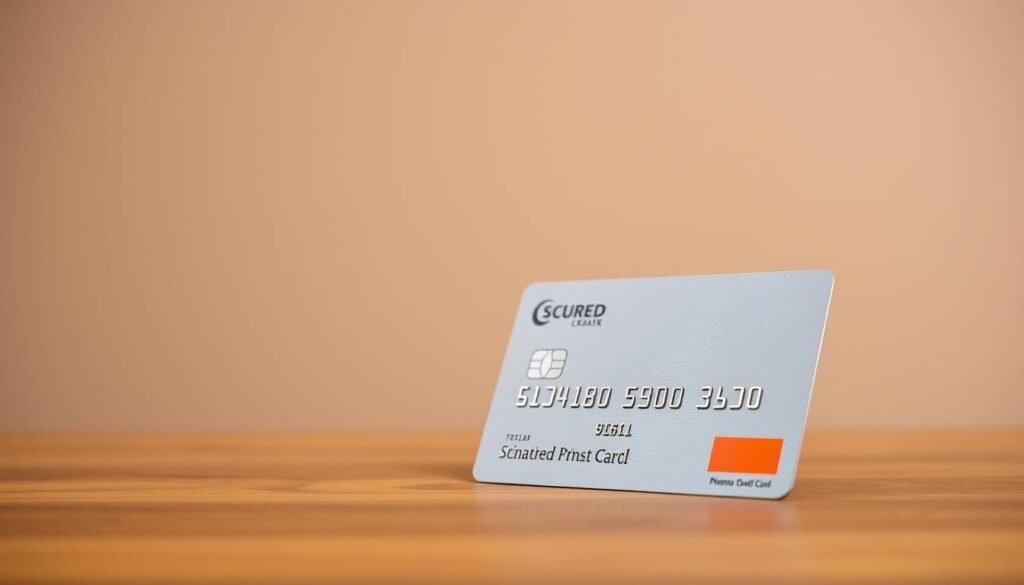
Build Credit with Secured Credit Cards for Students Canada

You arrive at university with a tight budget and big plans. On your first week, you sign up for a low-deposit Neo Secured Mastercard to handle small buys and earn cash back. It reports to Equifax and TransUnion, so your on-time payments start to shape your credit history.
The neat part? Neo accepts a $50 minimum security deposit and offers an insights dashboard and autopay. Those small, regular payments help your score and show lenders you can manage an account.
Over months, timely use and low utilization can help you move to an unsecured option in about 6–18 months. We’ll show how deposit size, reporting, fees and interest affect your path.
Read on to learn which options give real rewards, clear approval odds, and tools to keep payments on time so you can build credit while you study.
- Your search intent: find and compare secured options that build credit fast
- Who should get a secured card in Canada
- How we choose the best secured cards (what matters for you)
- Best picks at a glance for students in Canada
- Neo Secured Mastercard: why it’s the top choice right now
- Neo World Elite/World Secured: premium perks for everyday spending
- Home Trust Secured Visa: no annual fee, steady bureau reporting
- Capital One Guaranteed Secured Mastercard: low minimums, easy path
- Secured Tims Mastercard: store brand angle students may like
- KOHO Prepaid Mastercard: a non-secured alternative that reports
- secured credit cards for students Canada: what to compare before you apply
- Canada-specific eligibility: age of majority, residency, and approvals
- Using secured cards to build credit the right way
- Compare costs and features side by side
- Security deposits in practice: access, GIC options, and refunds
- Alternatives if a secured card isn’t your best fit
- Next steps to start building your Canadian credit history today
Your search intent: find and compare secured options that build credit fast
You want fast approvals and low deposits so you can start building a score without waiting. Focus on issuers that report to both Equifax and TransUnion and have clear, low-cost terms.
What to look for today:
- Approval odds: choose cards with flexible criteria and online applications; some don't require a hard credit check.
- Low deposit: options like the Neo card accept a $50 deposit, which helps if cash is tight.
- Rewards that matter: cash back can offset essentials just keep balances at zero to avoid interest and fees.
Practical tip: prioritize dual-bureau reporting and transparent fee schedules so your on-time payments show up quickly and your limit can grow as you prove good spending habits.

Who should get a secured card in Canada
A refundable deposit can be the simplest bridge to a Canadian file when your history is thin or damaged. A low-deposit option lets you start small, make reportable purchases, and show consistent on-time payments.
Students, newcomers, and anyone rebuilding after a setback
If you have no local file, a secured credit card helps you open a profile with Equifax and TransUnion. Use the account for small, regular bills and pay the balance in full each month to build positive credit history.
- Students without a Canadian record: a small security deposit creates an initial limit and reports activity so your score can grow.
- Newcomers: a refundable deposit acts as deposit collateral when you can’t yet get regular credit.
- Rebuilding after missed payments: these options offer easier approvals and a structured path to rebuild credit over 6–18 months.
“A modest limit is often enough to automate a phone plan or streaming bill and prove steady payments.”
Choose a low-fee product and keep balances low. Responsible use and an open account are the fastest ways to move to an unsecured product when your profile improves.

How we choose the best secured cards (what matters for you)
We score each option by how well it helps you build a reliable payment record and move up to a regular account.
Our method looks at fees, reporting, and practical value. We weigh annual or monthly fee versus real rewards, approval odds, and how easy the account is to manage.
Reporting and limits
Reporting to both bureaus is top priority. Cards that report to Equifax and TransUnion let every on-time payment boost your profile.
Deposits, limits and fees
Minimum security deposit matters. Lower deposits like Neo’s $50 entry let you start sooner. Home Trust’s $500 deposit is higher but often has no annual fee.
Rewards, rates and eligibility
We compare cash back categories, interest rates, and whether the product matches student spending. Eligibility checks and whether a hard credit check happens also shape our ranking.
- Clear terms and autopay: helps keep your payments on time.
- Upgrade paths: important so you’re not stuck at a low limit.
- Consumer feedback: support quality and consistent reporting matter.
| Issuer | Reports to | Min deposit | Fee |
|---|---|---|---|
| Neo | Equifax & TransUnion | $50 | Annual fee varies |
| Home Trust | Equifax & TransUnion | $500 | No annual fee |
| KOHO Credit Building | Equifax | Monthly fee | Monthly fee |

"The best pick balances accessibility, low costs, meaningful rewards, and reliable bureau reporting."
Best picks at a glance for students in Canada
This snapshot highlights options that balance low deposits, useful perks and reliable reporting.
Best overall: Neo Secured Mastercard
Why pick it: ultra-low $50 security deposit, no annual fee, cash back and dual-bureau reporting. APR ranges 19.99%–29.99% depending on province.
Why pick it: higher deposit (from $200), stronger earn rates and travel or purchase protections. There is an annual fee that suits higher spenders.
Best no-fee basic builder: Home Trust Secured Visa
Why pick it: no annual fee, $500 deposit minimum and steady reporting to Equifax and TransUnion. Purchase APR ~19.99%.
Best low-barrier backup: Capital One Guaranteed Secured Mastercard
Why pick it: easier approvals, low minimums and a predictable APR around 21.90% a solid fallback if other apps fail.
Worth a look (not secured): KOHO Prepaid with Credit Building
Why pick it: prepaid set-up that reports to Equifax for $10/month and offers cash back. The reporting fee can add up versus a no-fee route.
"Each pick balances deposit size, fees, rewards and reporting so you can choose what fits your budget and goals."
| Product | Min deposit / fee | Reporting | APR / notes |
|---|---|---|---|
| Neo Secured Mastercard | $50 deposit, no annual fee | Equifax & TransUnion | 19.99%–29.99% purchases; cash back |
| Neo World Elite / World Secured | From $200, annual fee applies | Equifax & TransUnion | Premium perks; higher earn rates |
| Home Trust Secured Visa | $500 deposit, no annual fee | Equifax & TransUnion | 19.99% purchases and cash advance |
| Capital One Guaranteed Secured Mastercard | Low minimums | Reports (issuer dependent) | ~21.90% APR; easier approvals |
| KOHO Prepaid with Credit Building | $10/month to report | Equifax | Cash back; monthly fee totals ~$120/yr |
Quick advice: pick a product that matches the deposit you can set aside and the places you spend most groceries, gas and recurring bills will deliver the best rewards.
Neo Secured Mastercard: why it’s the top choice right now
Neo makes starting simple if you need a low-barrier way to build your score. You can open an account with just a $50 security deposit and no annual fee, then use everyday purchases to show steady payments.
Key features:
- You can begin with only a $50 deposit, so access is easy even on a tight budget.
- The card reports to both Equifax and TransUnion, so on-time payments help your file at both bureaus.
- You earn cash back on everyday spend rare for a secured credit card which gives value while you build history.
The app shows real-time credit data, spending insights, and supports autopay so you rarely miss a due date. Flexible limit controls help you manage utilization and keep balances low.
Watch the purchase APR range by province
Purchase APR can vary between 19.99% and 29.99% depending on province and application. Avoid interest by paying in full each month.
"Start small, pay on time and your account can become the bridge to better options and higher rewards."
For regular spenders who want perks and protection, Neo’s premium World and World Elite secured options add real value. These tiers start at a $200 security deposit and carry an annual fee, but they also raise cash back caps and offer stronger benefits than basic products.
Premium perks include extended warranty, purchase protection, rental car insurance and travel coverage. These features are rare on a secured credit card and can save you money when you travel or buy higher-value items.
Rates are in line with other Neo products: about 19.99% on purchases and roughly 22.99% on cash advances. To avoid interest, pay your statement in full each month.
- Higher rewards: bigger cash back caps reward steady monthly spend.
- Boost option: you can increase cash back with a qualifying Neo Everyday account balance; your security deposit does not count toward the boost.
- Manage your limit: set a limit you can pay off to keep utilization low and protect your credit.
If you spend enough each month, the extra perks and protections can justify the annual fee. If your spending is modest, compare no-fee options to be sure you get net value.
"The premium secured route can be a practical bridge to an unsecured premium card once your profile matures."
Home Trust Secured Visa: no annual fee, steady bureau reporting
If you prefer a straightforward path, Home Trust offers a predictable Visa that focuses on steady reporting and no yearly charge.
What it does: This no-fee option uses a $500 security deposit to set your starting limit and reports activity to Equifax and TransUnion. That steady reporting helps build your credit history when you make on-time payments.
There are no rewards on the no-fee version. The emphasis is pure: disciplined use, low utilization and consistent payments help your profile most.
- No annual fee keeps costs down while you build.
- $500 deposit establishes a practical starting limit.
- 19.99% purchase and cash advance avoid carrying a balance to escape interest.
| Feature | Detail | Why it matters |
|---|---|---|
| Reporting | Equifax & TransUnion | Both bureaus record your payments |
| Deposit | $500 | Sets a clear starting limit |
| Rates | 19.99% purchase / 19.99% cash advance | Pay in full to avoid interest |
"A no-frills Visa can be the best way to build a steady file when you want predictability over perks."
Capital One Guaranteed Secured Mastercard: low minimums, easy path
If approvals have been tough, this card often works when other apps fail.
Why it helps: the issuer is known for friendly approvals and low minimum deposit requirements. That makes it a practical fallback when you need an accessible option to rebuild your profile.
Practical notes: the APR sits around 21.90%, so pay balances in full each month to avoid interest. Many users report success even during consumer proposals, which underlines its accessibility.
- Typically no annual fee keeps ongoing costs low.
- Some features require a text-enabled number confirm alerts when you sign up.
- Upgrades often need a new application, so keep the account open while you explore other offers.
"Use small, predictable purchases and pay on time to keep utilization low and lift your score."
| Feature | What to expect | Why it matters |
|---|---|---|
| Approval odds | Friendly; works when others decline | Helps you get a reportable account sooner |
| Deposit | Low minimum | Makes it easier to set a workable limit |
| Fees & APR | No annual fee; ~21.90% APR | Pay in full to avoid interest charges |
| Account features | Text alerts may be required; upgrades via reapply | Know setup details to avoid surprises |
Secured Tims Mastercard: store brand angle students may like
If you grab Tim Hortons coffee most mornings, a store-branded option can turn routine buys into real value. The Secured Tims Mastercard pairs a $0 annual fee with store-focused rewards that may suit your daily habits.
What to know: NerdWallet lists purchase APR from 20.99%–26.99% and cash advance APR from 22.99%–27.99%. Reported no hard credit check can make approval smoother when you’re just starting out.
Think of this as a practical, low-cost way to earn on meals and drinks you already buy. Pair the card with autopay so your statement balance clears before the due date. That keeps interest off your account and helps build a steady record of on-time payments.
- Zero annual fee helps keep ongoing costs low.
- Store rewards can be valuable if you actually spend at Tim Hortons often.
- Watch APR paying in full each month avoids interest that erodes any rewards.
Compare the reward mix and redemption rules to Neo or KOHO if you want broader cash back or dual-bureau reporting. Store-brand options can be a fun, useful fit when the perks match your routine.
"If your regular spending lines up with the partner network, a store card can add real value to everyday buys."
KOHO Prepaid Mastercard: a non-secured alternative that reports
If you want a deposit-free route to start a reportable account, KOHO’s prepaid option deserves a close look.
KOHO Essential is a prepaid Mastercard that isn’t a secured product, but it can help you build a Canadian file when paired with the Credit Building add-on.
Monthly fee for credit building versus secured card deposits
For $10 per month KOHO reports your payments to Equifax. That works like a low-friction way to establish a credit history without tying up a deposit.
- Cost: the reporting add-on equals about $120 per year versus a one-time refundable deposit on many starter options.
- Budgeting: prepaid accounts limit spending to what you load, so you avoid carrying a balance and pay on time more easily.
- Perks: cash back on essentials, boosted rewards on higher plans, free e-transfers and no foreign transaction fees on select tiers.
- Trade-off: no deposit helps upfront, but ongoing fees may outpace a low-deposit, no-fee secured option over 12 months.
Tip: compare the annual cost vs a refundable deposit and your expected rewards. If you want a quick comparison of starter options, see our guide to the best secured credit cards.
secured credit cards for students Canada: what to compare before you apply
Start by lining up the numbers: deposits, fees and how quickly your limit can grow. A clear comparison saves time and helps you avoid surprises when the statement arrives.
Minimum deposit, credit limit growth, and graduation paths
Compare deposits carefully. Neo starts at $50, Neo World options from $200 and Home Trust typically asks $500. Capital One often accepts low minimums.
Ask the issuer how fast they raise your credit limit and what triggers a formal graduation to an unsecured product.
Annual and monthly fees, interest rates, and foreign transaction fees
Balance any annual fee or a KOHO $10/month reporting charge against real value you’ll get. Neo’s purchase APR ranges roughly 19.99%–29.99% depending on province. Plan to pay in full monthly to avoid interest rates and watch foreign transaction charges if you buy US textbooks or travel.
Cash back categories and how rewards stack up for student budgets
Pick rewards that match your spending habits. Groceries, transit and recurring bills usually give the best return. If a product carries an annual fee, be sure the cash back and perks offset that cost.
- Check whether the issuer reports to Equifax and TransUnion or just one bureau.
- Read how deposits are handled and what refund rules apply.
- Prefer apps with autopay and alerts to keep on-time payments consistent.
“Compare deposits, fees and reporting closely the best starter option matches your budget and daily spending.”
Canada-specific eligibility: age of majority, residency, and approvals
Before you apply, confirm you meet basic legal and residency rules that issuers check. Most products require you to be the age majority in your province or territory and a Canadian resident to open an account.
You should also have funds ready to fund the minimum deposit once your application is approved. Some banks allow online sign-up while others may ask you to visit a branch.
What issuers may check (and when no hard pull applies)
Issuers typically verify ID, residency and basic income. They may run a soft or hard inquiry. A hard inquiry is a formal credit check and can affect future approvals if done repeatedly.
- No hard pull options: select issuers sometimes skip the hard inquiry check terms and conditions before you apply.
- Avoid multiple applications in a short period; many hard checks can lower approval odds.
- Keep ID and financial details handy to speed processing, and set up autopay so payments start on time.
"Always verify eligibility details on the issuer’s site, as policies may evolve."
For a broader look at card options and market context, see curated lists of the best credit cards.
Using secured cards to build credit the right way
Small, steady actions each month can change how lenders see you over time. Start with clear, repeatable habits and focus on reporting that shows regular, on-time activity.
Keep utilization low and pay on time, every time
Keep your utilization under 30% of your limit and aim to pay the full statement balance each month. Low utilization and perfect on-time payments are the single best way to build a solid profile.
Autopay, small recurring bills, and monitoring your score
Put one or two small recurring bills on your card and enable autopay so you never miss a due date. That creates a predictable trail of monthly payments.
- Monitor your score regularly with both bureaus if possible.
- Watch alerts and statements so errors get fixed quickly.
- Avoid carrying a balance interest adds cost and can lead to missed payments.
How fast you can move to an unsecured card
Most people progress to an unsecured option in about 6–18 months with consistent reporting and timely payments. Dual-bureau reporting often speeds that timeline.
"Start small, keep balances low and ask your issuer about review windows many will upgrade you once your history proves reliable."
Compare costs and features side by side
Weighing costs alongside benefits helps you pick a starter card that actually fits your monthly budget. Take a quick, realistic view of upfront deposits, ongoing charges and the true value of any rewards.
Deposits: $50 vs $200 vs $500 what’s realistic for you
Neo can start from $50, premium Neo World tiers from $200, while Home Trust commonly asks $500. Capital One often accepts low minimums.
Fees and APR impact if you ever carry a balance
Monthly plans like KOHO’s $10 reporting add-up. Neo purchase APR runs about 19.99%–29.99%. Home Trust sits near 19.99% and Capital One around 21.90%.
"If there's any chance you'll carry a balance, prioritize lower interest and fewer fees."
Rewards trade-offs on secured cards
Rewards and cash back are improving, but an annual fee or monthly charge can erase gains quickly. Pick earn rates that match groceries, transit and bills you already pay.
| Feature | Low deposit | Higher deposit |
|---|---|---|
| Example | Neo $50 | Home Trust $500 |
| APR / fees | Neo 19.99%–29.99% / varies | Home Trust 19.99% / no annual fee |
| Best if | You need low upfront cash | You want predictability and no annual fee |
- Start with a deposit that won’t strain your budget.
- Choose issuers that let you increase limits as your finances improve.
- Compare a one‑time refundable deposit versus ongoing monthly plan fees.
Security deposits in practice: access, GIC options, and refunds
How an issuer holds and refunds your deposit matters as much as the amount you send.
Your deposit is collateral and usually sets your starting limit. It is not spendable; instead it unlocks the secured credit card and defines the protection the issuer has if you leave a balance.
Some issuers place deposits into a GIC so the funds earn interest while you build a payment record. Ask whether your money grows and how interest is paid or reported.
Refund rules vary. If you close or upgrade with no balance due, you typically get your deposit back often within about 60 days. If you owe fees or a balance, the issuer will deduct those amounts first.
- Minimums commonly sit between $50 and $500; plan to fund what the approval email asks.
- Maximum limits can range from $2,500 to $10,000 as you grow the account and ask for raises.
- Keep on-time payments so you don’t force the issuer to use your deposit to cover charges.
| Item | Typical detail | Why it matters |
|---|---|---|
| Where funds are held | Issuer account or GIC | Determines interest and access rules |
| Refund timing | ~60 days after zero balance/closure | Helps you plan cash flow |
| Deductions | Outstanding balance or fees | Deposit may be reduced before refund |
| Min / Max limits | $50–$500 min; $2,500–$10,000 max | Sets starting limit and future headroom |
"Always read the issuer’s terms and check how your deposit is held and refunded."
Alternatives if a secured card isn’t your best fit
Not everyone wants to tie up cash thankfully, useful alternatives exist that still help you build a reliable profile.
Credit-building loans are one clear option. These small loans place the principal in a locked account while you make monthly payments that report to bureaus. Over time, steady payments help rebuild credit history without a deposit.
Credit-building loans and balance transfer strategies
Balance transfer credit cards with promotional rates can lower your interest while you pay down an existing balance. If you have debt, a 0% promo period can save money on interest and speed up payoff.
- If you can’t or don’t want a deposit, try a builder loan that reports on-time payments.
- Prepaid routes like KOHO’s Credit Building add-on report to Equifax for $10/month and suit people who prefer a monthly fee over a deposit.
- Community lenders and credit unions may offer tailored builder programs for newcomers and students.
- Check all fees and promo terms so the math actually saves you money.
| Option | How it helps | Watch for |
|---|---|---|
| Builder loan | Reports payments | Setup fees |
| Balance transfer | Lower interest | Transfer fees, promo length |
| Prepaid + reporting | No deposit | Monthly fee vs deposit |
Quick tips: avoid many new applications after recent hard checks, keep any regular credit card open with light use, and reassess in six months as your profile improves, more offers will appear.
"Always prioritise on-time payments and low balances those habits drive most of your score."
Next steps to start building your Canadian credit history today
Take the first step: select a starter that matches what you spend and can afford. Pick a secured credit card with a low deposit, low fees and dual‑bureau reporting so your on‑time activity counts.
Apply online, fund the deposit promptly, and set up autopay before your first statement to lock in steady payments. Put a couple of small recurring bills on the card and pay the balance in full each month.
Monitor your progress monthly and watch for issuer reviews at the 6–12 month mark that may lead to an upgrade. Keep your oldest account open and avoid multiple applications while you build clean, consistent on‑time behavior is the surest path to a better score and good credit.
If you want to know other articles similar to Build Credit with Secured Credit Cards for Students Canada you can visit the category Finance.






Leave a Reply